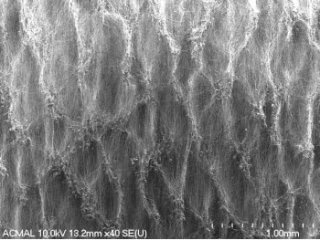Mar 28 2019
Electrospinning uses electric fields to control microscale and nanoscale fibers. The method is strong but tedious and expensive. Researchers from Michigan Technological University have come up with a new way to develop customizable nanofibers for growing cell cultures that sidestep time taken for removing toxic chemicals and solvents. Their efforts are published in Elsevier’s Materialia (DOI: 10.1016/j.mtla.2019.100296).
 Although the material texture is visible to the naked eye, microscopic images reveal the intricacy of the structure. (Image credit: Smitha Rao)
Although the material texture is visible to the naked eye, microscopic images reveal the intricacy of the structure. (Image credit: Smitha Rao)
Smitha Rao, assistant professor of biomedical engineering at Michigan Tech, led the study. She said the method is groundbreaking, “we’re coming at this completely sideways,” and the team concentrated on refining electrospun nanofiber production. Nanofibers are employed as scaffolds, composed of strands and pockets that can grow cells.
We want an assembled, highly aligned scaffold that has ideal structures and patterns on it that cells will like. Take a cell, put it on porous materials versus elastic materials versus hard materials, and it turns out the cell does different things. Usually you use varied materials to get these diverse characteristics. Cells respond differently when you put them on different surfaces, so can we make scaffolds that provide these different conditions while keeping the materials the same?
Smitha Rao, Assistant Professor of Biomedical Engineering, Michigan Tech.
Nanofiber Strands and Pockets
Briefly, yes. Plus, making modifiable scaffolds is astonishingly simple, particularly when compared to the difficult casting and additive processes commonly used to create scaffolds ideal for electrospinning. Furthermore, Rao’s team found a satisfying side effect.
“We take the polymers, then we put them into solutions, and we came up with this magical formula that works—and then we had to go electrospin it,” Rao explained, adding that the team observed something strange during the process.
“We saw that the cells aligned without us applying anything externally. Typically, to make them align you have to put them in an electric field, or put them in a chamber and agitate the scaffold to force them to align in a particular direction by applying external stresses,” she said. “We’re basically taking pieces of this scaffold, throwing it in a culture plate and dropping cells on it.”
When spun in an electric field—visualize a cotton candy machine—the self-aligning cells trail the strand-and-pocket pattern of the underlying nanofibers. Rao’s team, including lead author and PhD student Samerender Nagam Hanumantharao and master's student Carolynn Que, discovered that varying electric field strengths led to various pocket sizes. At 18 kilovolts, the magic takes place and the fibers align just right. At 19 kilovolts, small pockets develop, suitable for cardiac myoblasts. At 20 kilovolts, honeycombs of pockets grow in the fibers. Bone cells favor the pockets created at 21 kilovolts; dermal cells are not choosy, but particularly like the roomy pockets that grow at 22 kilovolts.
Multi-strand Nanofibers
Rao’s team tested a range of polymer mixes and learned that a few of the most common materials stay tried-and-true. Their magical two-polymer blend allows them to exploit the nanofiber pocket size; a three-polymer blend made alteration of the mechanical properties possible. The polymers include polycaprolactone (PCL), biodegradable and not tough to shape, and conductive polyaniline (PANI), which together formed a two-polymer blend, which could be integrated with polyvinylidene difluoride (PVDF).
Because polyaniline is conducting in nature, people can throw it into the fiber matrix to get conductive scaffolds for cells such as neurons. However, no one has used these materials to manipulate the process conditions.
Smitha Rao, Assistant Professor of Biomedical Engineering, Michigan Tech.
Being able to use the same materials to develop various nanofiber features means removing physical and chemical variables that can make the experimental results messy. Rao believes that as more scientists use her team’s process and blends, it will accelerate research to properly understand neural mechanisms, expedite wound healing technology, test cell lines, and improve fast prototyping in biomedical engineering.
We’re trying to simplify the process to answer a highly complex question: how do cells proliferate and grow? This is our basic building block; this is the two-by-two Lego. And you can build whatever you want from there.
Smitha Rao, Assistant Professor of Biomedical Engineering, Michigan Tech.